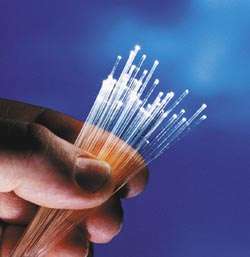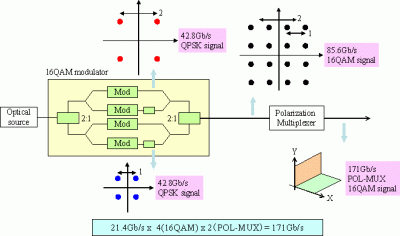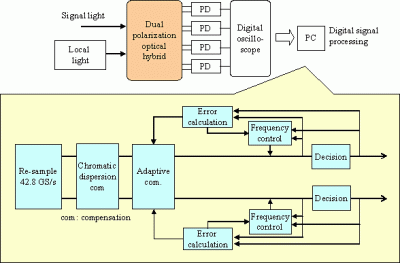Nippon Telegraph and Telephone Corp have successfully demonstrated an ultra-high capacity optical transmission of 69.1 terabits per second over a single 240 km long optical fiber.
(PhysOrg.com) -- With the increasing high volume content over the internet, such as multimedia and high definition images, new transmission methods need to be found to handle the increasing data demand. Nippon Telegraph and Telephone Corp (NTT) have successfully demonstrated an ultra-high capacity optical transmission of 69.1 terabits per second over a single 240 km long optical fiber.
NTT was able to achieve 69.1 Tb/s transmission by applying wavelength division multiplex (WDM) of 432 wavelengths with a capacity of 171 Gb/s. This is the highest optical transmission ever recorded in the transmission field. This technology will prove beneficial in the construction of high-capacity optical backbones for the future.
In NTT’s experimental setup, a 171Gb/s signal per wavelength is generated by the combination of the 16 QAM format (quadrature amplitude modulation) with polarization division multiplexing in the transmitter. The 16 QAM signal is generated by combining two QPSK (Quadrature phase-shift keying) signals with an amplitude ratio of 2:1 in the QAM modulator. Four hundred and thirty optical signals from 1527 to 1620 nm with a wavelength spacing of 25 GHz are multiplexed to generate a 69.1 Tb/s signal.
Generation of 171 Gb/s signal using 16 QAM format and polarization division multiplexing. Credit: Nippon Telegraph and Telephone Corporation.
The receiver uses coherent detection and digital signal processing. The 16 QAM signal is demodulated by using a new algorithm without deploying pilot-less processing. The signal processing is also used equalize the wavelength distortion caused by the chromatic dispersion and the polarization mode dispersion that occurs during optical transmission.
Digital coherent signal processing is deployed in the receiver. Credit: Nippon Telegraph and Telephone Corporation.
NTT’s objective is to construct an optical backbone network with high-capacity and long-distance transmission based on rates over 100 Gb/s per wavelength and over 10 Tb/s per fiber. This will lead to an optical backbone network that is more cost effective and have greater performance.
More information: www.ntt.co.jp/news2010/1003e/100325a.html
© 2010 PhysOrg.com




















